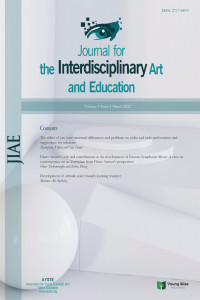The “strange affinities”: early Chinese American Vaudevillians’ blackface performance
The “strange affinities”: early Chinese American Vaudevillians’ blackface performance
Vaudeville, Chinese American, blackface, Black Theatre Performance Studies,
___
- Another Vaudeville Assistant. (1938, November 7). The New York Clipper.
- Ash in Chinese or Any Costume Gives Crowds Right Show. (1926, January 23). Exhibitors Herald.
- Bhabha, H. K. (1983). The Other Question…. Screen, 24(6), 18–36. https://doi.org/10.1093/screen/24.6.18
- Blackface Gives Way to Chinese Minstrel Motif. (1921, December 4). Democrat and Chronicle, 4.
- Caldwell, D. (1971). The Negroization of the Chinese Stereotype in California. Southern California Quarterly, 53(2), 123–131. https://doi.org/10.2307/41170344
- Case, T., & Sponable, E. (Directors). (n.d.). Unseen Cinema Vol. 6: Amateur as Auteur.
- Cather, H. V. (1974). The history of San Francisco’s Chinatown. R And E Associates.
- Chinese Minstrels Please With Blackface Comedy. (1928, December 29). The Hanford Sentinel, 4.
- Ching Ling Foo and Co. (1923, February). Variety Vol 69, 16.
- Chung Mei Minstrels. (1928, December 28). The Hanford Sentinel, 5.
- Chung Mei Minstrels in Selma. (1925, April 3). The Selma Irrigator, 5.
- Foo, L. T. (1914, August 11). Lee to Alverson [Letter to Margaret Blake Alverson].
- Foo, L. T. (1915). Lee to Alverson [Letter to Margaret Blake Alverson].
- Garrett, C. H. (2004). Chinatown, Whose Chinatown? Defining America’s Borders with Musical Orientalism. Journal of the American Musicological Society, 57(1), 119–174. https://doi.org/10.1525/jams.2004.57.1.119
- Horsman, R. (1981). Race and manifest destiny : the origins of American racial Anglo-Saxonism. Harvard Univ. Press.
- Jones, A. F., & Nikhil Pal Singh. (2003). The Afro-Asian century. Duke University Press.
- Krasner, D. (1995). Parody and Double Consciousness in the Language of Early Black Musical Theatre. African American Review, 29(2), 317–323. https://doi.org/10.2307/3042310
- Krasner, D. (1998). Resistance, parody, and double consciousness in African American theatre : 1895-1910. St. Martin’s Press.
- L, J. (1919, April 23). New Acts. Variety, 25.
- Lee, J. (1998). Performing Asian America : Race and Ethnicity on the Contemporary Stage. Temple University Press.
- Lei, D. P.-W. (2006). Operatic China : staging Chinese identity across the Pacific. Palgrave Macmillan.
- Lye, C. (2008). The Afro-Asian Analogy. PMLA, 123(5), 1732–1736. https://doi.org/10.1632/pmla.2008.123.5.1732
- Moon, K. R. (2005). Yellowface : creating the Chinese in American popular music and performance, 1850s-1920s. Rutgers University Press.
- Mullen, B. (2004). Afro-Orientalism. University Of Minnesota Press.
- Nee Wong. (1925, December 12). Exhibitors Herald.
- Nee Wong Coolie. (1927, April 18). The Kansas City Times, 11.
- Nee Wong Gent of the Orient. (1928). National Vaudeville Artists’ Year Book, 168.
- Nee Wong the Orient. (1927, November 27). Battle Creek Enquirer, 21.
- New “Topsy” on Stage. (1928, March 16). Oakland Tribune, 27.
- New Acts of the Week. (1906, June 16). Variety, 8.
- New Acts This Week. (1921, May 13). Variety, 21.
- Shun Tock & Yen Wah. (1922, January 28). Daily News, 17.
- Slide, A. (2012). The Encyclopedia of Vaudeville. University Press Of Mississippi.
- The Sorcerer’s Apprentice. (1925, September 25). Motion Picture News.
- This week performance. (1913, January). Variety.
- This week’s vaudeville reviews. (1914, February 11). Billboard, 10.
- Vaudeville. (1922, August 23). The New York Clipper, 11.
- Williams-Leon, T. (2001). The Sum of Our Parts: Mixed-Heritage Asian Americans (C. L. Nakashima, Ed.). Temple University Press.
- World’s Only Chinese Baritone. (1906, December 24). Keith’s News (Providence, R.I.), 3–4.
- Young, G. M. (1913, August). Philadelphia. Variety, 27.
- Figure References Lee Tung Foo in traditional Scottish Highlander costume, 1920s, Courtesy of California State Library.
- Lee Tung Foo in traditional Chinese dress, 1921, Courtesy of the California State Library
- “Shun Tock & Yen Wah,” Shun Tock & Yen Wah. (1922, January 28). Daily News, 17.
- “Chung Mei Minstrels,” Chung Mei Minstrels. (1928, December 28). The Hanford Sentinel, 5.
- “New ‘Topsy’ on Stage,” Chung Mei Minstrels. (1928, December 28). The Hanford Sentinel, 5.
- The program of Chung Mei Minstrels, Chung Mei Minstrels in Selma. (1925, April 3). The Selma Irrigator, 5.
- The Birth Certificate of Nee Wong,1942, Courtesy of the California State Library.
- “Another Vaudeville Assistant,” Another Vaudeville Assistant. (1938, November 7). The New York Clipper.
- The portrait of Nee Wong, Case, T., & Sponable, E. (Directors). (n.d.). Unseen Cinema Vol. 6: Amateur as Auteur.
- Nee Wong in National Vaudeville Artists’ Year Book, Nee Wong Gent of the Orient. (1928). National Vaudeville Artists’ Year Book, 168.
- Yayın Aralığı: Yılda 4 Sayı
- Başlangıç: 2020
- Yayıncı: Genç Bilge Yayıncılık
The anatomical analysis of basic stance in ballet
Seda AYVAZOĞLU, Gökben Feda DÜNDAR
The “strange affinities”: early Chinese American Vaudevillians’ blackface performance
Reflections on the direction of the theatre after the experience of the Corona Pandemic.
